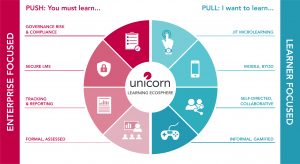Demonstrating competence and regulatory compliance is a serious business. After all, the costs of non-compliance can be very severe. So, is it possible to harness the power of new learning technologies to reduce the business risks and bring genuine cultural change in your business.
The way we digest information is completely different now to 20 years ago. We live in a world where more people on Earth have access to a mobile phone than to a toilet. According to Apple (Business Insider 2016), iPhone users unlock their phone an average of 80 times per day, and this doesn’t include tablet use.
Yet T&C and compliance requires formal training, record keeping and reporting, and compliance eLearning is largely completed at the desktop, on company premises and behind a secure firewall.
Much traditional eLearning reflects this environment; it’s mandatory, linear, serious ‘must do’ learning and assessment, none of which, on the surface at least, sit comfortably with the more unstructured, informal, social nature of mobile learning.
So is it possible to marry these worlds to deliver more meaningful and enduring learning and to achieve cultural and behavioural change within even the most highly regulated businesses?
Where are we now?
In its broadest form the FCA defines competence as “having the skills, knowledge and expertise needed to discharge the responsibilities of an employee’s role,” including achieving a good standard of ethical behaviour.
What isn’t explicitly stated is how this can be achieved.
To meet this definition, T&C must inevitably be driven by the needs of the enterprise to ensure staff are competent to do their jobs and to be able to record and report on that. This means a focus on systems and processes, product knowledge, governance, risk and compliance, and requires a degree of central control, monitoring, reporting and an audit trail, in turn requiring a secure enterprise LMS.
Such a set-up means T&C and compliance eLearning has almost inadvertently become characterised by ‘click next’ tick box courses – dry facts set out in a mundane format that provides little incentive to do more than the bare minimum as fast as possible to enable an employee to pass the assessment and get back to work.
Yet this is the antithesis of how we in our personal lives now gather information and learn informally. It also runs counter to all the research around the ‘forgetting curve’ and the importance of regularly refreshing learning and putting it into context to ensure true retention.
As T&C and L&D professionals, we cannot be satisfied with the tick box mentality. We know genuine risk management requires changing mindsets and reinforcing the right behaviours, ethics and standards. Luckily there is help at hand.
Mobile technologies now provides us with a platform for engaging learners, and not only gaining but also maintaining and reinforcing the “skills, knowledge and expertise needed to discharge the responsibilities of an employee’s role”.
So vive la révolution, let’s all wave our phones in the faces of anxious compliance officers and demand our independence from the chains of the desktops.
Or perhaps not quite yet…
A recent Unicorn survey of over 100 financial services companies found that even when their eLearning courses were converted to be responsive and mobile compatible, almost 95% of users still studied at their desktops on their work PC.
The unconscious bias remains that this learning is mandatory, it is compliance, quite probably it’s going to be boring, so they want to sit down for 30 minutes and get it over with. It seems, therefore, that even our tech savvy employees are not quite ready to abandon their deep-rooted perceptions of the ‘serious’ stuff.
So what’s needed is balance.
Where can we go?
We’ve already acknowledged the realities and pressures of the regulated world. We are not about to lay witness to a wholesale shift to mobile technologies, with staff eagerly studying their anti-money laundering course on the bus or at home.
But with apps and other forms of mobile interactions now just a normal part of our day-to-day lives, rather than looking to deploy full compliance content to mobile, apps can and should be focused on reinforcement. A learner may still be expected to complete a mandatory course on a particular topic, but the power of apps means we are now able to add extra layers to the learning experience to really embed the behavioural and cultural change aspired to within a business.
Mobile provides the ideal delivery medium for short spaced learning reinforcement to overcome the forgetting curve. To be effective, the learning has to be designed for mobile-first and this means short, micro-bites of content, particularly video, and it means delivery in an intuitive interface. Simple gamification elements, challenges, nudges and prompts, encourage regular revisits and improve learning retention.
When we reimagine learning in this non-linear way, we can start drawing in other psychological principles too – the challenge and reward balance, social collaboration and knowledge sharing, or just-in-time content that enables users to reference bite-sized supplementary learning content for reference in everyday situations.
Finding the balance between the two sides can help you deliver more effective training
A short test, completed through an app, can show a compliance officer or T&C manager whether an employee is continuing to meet the required competencies to do their job or whether further training or refresher learning, which can also be delivered through apps, is needed. In turn, employees are more comfortable with this too as not only is the monotony of doing the same mandatory courses every year overcome, especially if it’s subject matter they know, but they get flexibility too.

Most enterprise LMSs now include a bundled app so users can interact with the LMS from a mobile device, facilitating the accessing of learning in personal pathways, and recording offline activity.
As the people responsible for the record keeping and reporting for the regulator, you can use intelligent curation to guide that exploration and encourage collaboration. But resist the temptation to mandate it all or obsessively track individual progress, rather use these intelligent curation tools to provide staff with access to the latest high quality briefings on topics of your choice from across the web.
If you do need more central management and control, safe and secure APIs can enable single sign-on user authentication, allowing Apps to communicate with an LMS, with on and offline syncing. The xAPI standard enables learning outside an LMS to be recorded, with data passed back to the LMS in a standard format.
Conclusion
No matter how much we value the just-in-time access mobile brings, simply delivering traditional linear learning on mobile devices does not address the real benefits of leveraging new technology for learning. This is why designing learning interventions for mobile that reinforce and give practical context is the key to improving user engagement and enhancing knowledge retention.
This is something we’ve given a lot of thought to over the past year, and our thoughts are reflected in the development of our Learning Ecosphere white paper, published in January.
The Learning Ecosphere recognises how enterprise demands in terms of governance, risk and compliance, formal, assessed learning that can be tracked and reported on a secure LMS, continue to absorb the majority of training budgets. But the model also highlights how the learner-focused notions of just-in-time microlearning, self-directed and collaborative, informal, gamified and delivered via mobile/BYOD, holds great potential to augment and enhance personal learning experiences.
Finding the balance between the two sides can help you deliver more effective training that leads not just to greater knowledge retention but application, expertise, changes in behaviour and the embedding of new ethical cultures and standards.
No industry is immune to the anxieties of the changing ways people use technology in their everyday lives, and the challenge this presents to businesses in trying to harness and incorporate such technology into their employees’ working practices.
But by being sensitive to the valid compliance and evidencing concerns of those in the regulators’ sights, it is possible to make the different elements on both sides work harmoniously to the ultimate benefit of your business and employees.




